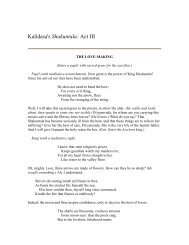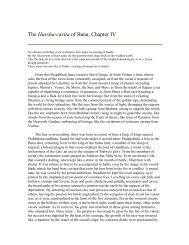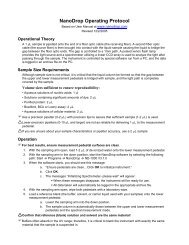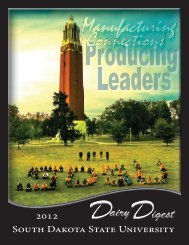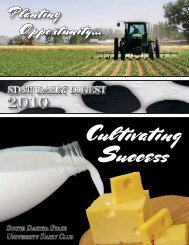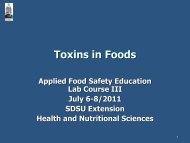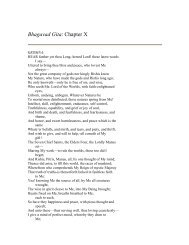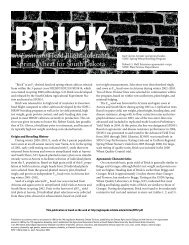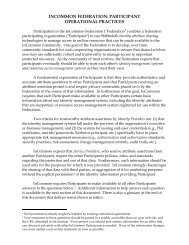2025 Design & Master Plan - South Dakota State University
2025 Design & Master Plan - South Dakota State University
2025 Design & Master Plan - South Dakota State University
You also want an ePaper? Increase the reach of your titles
YUMPU automatically turns print PDFs into web optimized ePapers that Google loves.
section 10 – landscape construction notes<br />
soil preparation<br />
Soil is a critical component of the landscape that relates directly to the long-term health and<br />
success of turf and plantings. Construction activity often leaves a site with poor soil quality and<br />
a heavily compacted soil profile. The result of these conditions is a landscape that requires<br />
excessive supplemental water and nutrient input to survive. Correcting these soil conditions prior<br />
to seeding and planting will result in a landscape that is more self-sustaining, less dependent on<br />
artificial fertilizers, a decreased or eliminated dependence on supplemental irrigation, and faster<br />
growing trees and plantings.<br />
Topsoil depth shall be a minimum of 6 inches for lawn areas, 18 inches for landscape beds,<br />
and 30 inches for parking islands. Refer to planting details for further topsoil application<br />
notes.<br />
Correct soil conditions in lawn and landscape areas on construction sites as follows:<br />
1) Maintain grade on construction site at a minimum of 6 inches below anticipated finished<br />
grade of site in order to adequately accommodate necessary subgrade preparation activities<br />
prior to topsoil placement.<br />
2) Loosen compacted subgrade. This allows for root and water penetration into a deeper soil<br />
mass, providing plants with an extra water reserve to buffer against heat stress. Loosening<br />
the subgrade should be done prior to placing topsoil material.<br />
3) Place topsoil. Topsoil should be a uniform mixture of organic matter, sand, silt and clay<br />
particles. It shall be pervious, friable and a darker shade of brown. Topsoil should be free of<br />
clay lumps, subsoil, grass, weeds, roots, stumps, toxic substances, litter, gravel, stones and<br />
other materials greater than 1 inch in diameter. Topsoil shall have a pH of 5.5 to 7.0.<br />
topsoil amendments<br />
When possible, amend topsoil in lawn and plant beds with compost as follows:<br />
• Lawn areas: 2 cubic yards of compost per 1,000 square feet<br />
• Landscape beds: 3-4 cubic yards of compost per 1,000 square feet<br />
Compost material is to be a well-composted, stable and weed-free organic matter; pH range<br />
of 5.5 to 8; moisture content 35 to 55 percent by weight; 100 percent passing through 1<br />
inch sieve; soluble salt content of 5 to 10 decisiemens/m; not exceeding 0.5 percent inert<br />
contaminants and free of substances toxic to plantings.<br />
figure 10.1: soil preparation notes<br />
a:15




